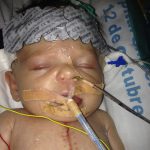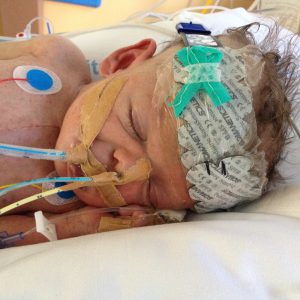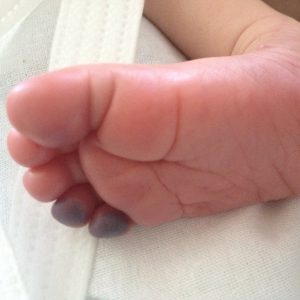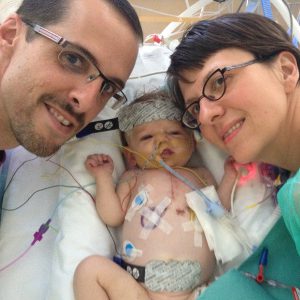
Fortunately, I was wrong. About 20 minutes later, Dr. Garcia returned, his demeanor visibly improved. They had successfully performed the Rashkind, and her oxygen levels were now up to 75%, which is where they needed to remain until Dr. Garcia could perform the arterial switch.
We were allowed to go back into the Pediatric Intensive Care Unit (PICU) to see Ari. For the first few seconds, I couldn’t make sense of what I was seeing. She was completely naked, spread-eagle on a small platform, surrounded by more machines than I could count, each one hooked up to her body- through her nose, over her mouth, wrapped around her toe, stuck on her now-shaved head. She was bloated, and completely motionless, eyes closed. But she was alive, and that was all that mattered.
The next two months were a crash course in living in the moment, day-to-day. For a few weeks, it didn’t seem like we could catch a break. The day after we arrived, we were told that tests indicated she had suffered a brain seizure. It would turn out that in fact she had lost the function of nearly a quarter of her frontal left lobe and there were “spots” throughout her brain that could worsen with surgery.
Then she destabilized a few days later, prompting Dr. Garcia to perform emergency open-heart surgery to surgically open up a pathway in her heart to ensure her O2 levels remained above 75%.
The day before she was scheduled to have surgery, another child arrived at the hospital who was determined to be in more critical condition than Ari. While the vote of confidence in Ari’s improving health was encouraging, in the interim before she could receive her corrective surgery, Ari would go septic and it would be another month of touch-and-go, sleeping next to her crib or with the phone under my ear, should she destabilize again.
Ch. 1: The First 6 Weeks
Ch. 2: To the ER
Ch. 3: The Transfer
Ch. 4: The Diagnosis
Ch. 5: The Rashkind Procedure
Ch. 6: 8 Weeks in PICU (this page)
Ch. 7: Ari’s Arterial Switch
Ch. 8: The End . . . and the Beginning




